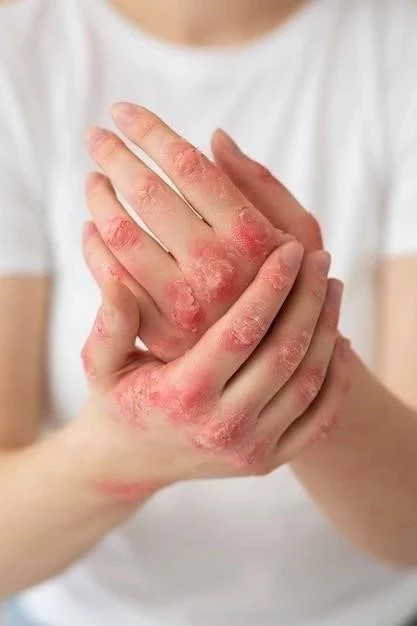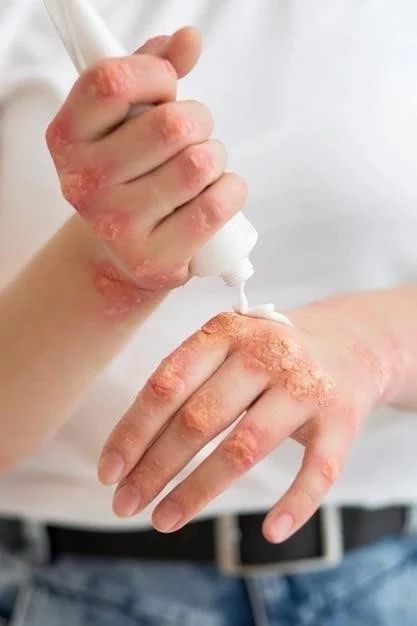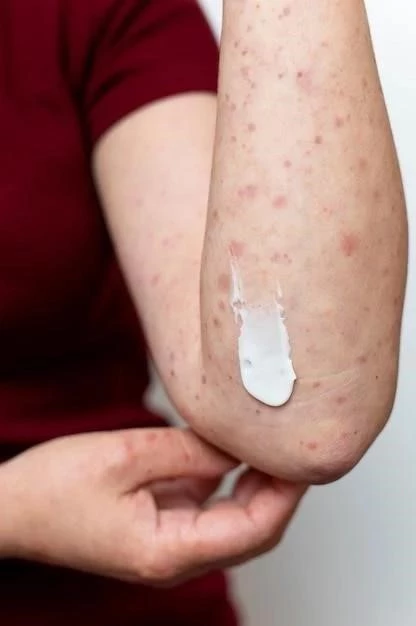

Tamoxifen Rash⁚ A Comprehensive Guide
This guide provides essential information about rashes associated with Tamoxifen, a medication frequently used in breast cancer treatment. Understanding the potential for skin reactions is crucial for effective management and patient well-being.
Understanding Tamoxifen
Tamoxifen is a selective estrogen receptor modulator (SERM) commonly prescribed for the treatment and prevention of hormone-receptor-positive breast cancer. It works by blocking estrogen’s effects on breast cancer cells, thereby slowing or stopping their growth. While highly effective, Tamoxifen can cause various side effects, one of which is a skin rash. The severity of this rash can range from mild to severe, and its appearance can vary significantly among individuals. Factors influencing the likelihood and severity of a rash aren’t fully understood, but individual sensitivity to the drug plays a role. It’s crucial to remember that while a rash is a possible side effect, many individuals taking Tamoxifen experience no skin reactions. Always discuss any concerns about side effects, including skin reactions, with your oncologist or healthcare provider. They can help assess the severity of your rash and determine the best course of action to manage it effectively and safely, ensuring your treatment plan remains on track. Open communication with your medical team is vital for a positive treatment outcome and managing any discomfort experienced.

Common Side Effects of Tamoxifen
Beyond skin rashes, Tamoxifen can induce a range of side effects, varying in severity and frequency among patients. Some common occurrences include hot flashes, vaginal dryness, and menstrual irregularities. These hormonal shifts often stem from Tamoxifen’s interaction with estrogen receptors. Weight changes, both gain and loss, are also reported. Gastrointestinal issues such as nausea and vomiting may appear, though usually mild. Changes in mood, including depression or anxiety, are possible side effects requiring attention and support. Thromboembolic events, such as blood clots, represent a more serious potential side effect requiring close monitoring. Bone thinning (osteoporosis) is another long-term concern, highlighting the importance of regular bone density checks. Less common side effects may include cataracts, changes in vision, and increased risk of uterine cancer. It’s vital to note that not everyone experiences all or even any of these side effects. The intensity and prevalence of these side effects can vary significantly from person to person. Regular communication with your healthcare provider is crucial for addressing any concerns and managing side effects effectively.
Recognizing a Tamoxifen Rash
Identifying a Tamoxifen-induced rash requires careful observation and awareness. Rashes can manifest in various ways, making early recognition crucial. They might appear as a widespread, itchy redness across the skin, or as localized patches of irritated skin. The rash might be accompanied by small bumps, blisters, or a scaly texture. Some individuals might experience only mild redness, while others might develop more severe reactions. The location of the rash can vary; it might appear on the face, torso, extremities, or a combination thereof. The onset of the rash can be gradual or sudden, making consistent self-monitoring essential. Paying close attention to any new skin changes during Tamoxifen treatment is vital. If you notice any unusual skin reactions, such as redness, itching, swelling, or blistering, it’s important to document the details – including the location, appearance, and any associated symptoms – to discuss with your doctor. Early identification enables prompt intervention and management of the reaction, minimizing discomfort and potential complications. Remember, early reporting facilitates the best medical response;
Types of Tamoxifen Rashes
Tamoxifen-related skin reactions exhibit a spectrum of presentations. Mild rashes often manifest as a subtle redness or slight itching, typically manageable with over-the-counter remedies. These often resolve without intervention. Moderate rashes might involve more pronounced redness, increased itching, and the appearance of small bumps or hives. These usually require medical attention for appropriate management. Severe rashes represent a more significant reaction, possibly including widespread redness, extensive swelling, blistering, or even skin peeling. These severe cases necessitate immediate medical consultation. The specific type of rash experienced can vary greatly depending on individual sensitivity and other factors. Accurate classification by a healthcare professional is crucial for determining the most effective treatment strategy. The distinction between mild, moderate, and severe is critical for guiding treatment decisions and ensuring patient safety and comfort. Always consult your doctor for diagnosis and guidance, as self-treating severe reactions can be dangerous.
Mild Rashes
Mild Tamoxifen rashes are characterized by subtle skin changes, often presenting as mild redness or a slight itch. The affected area may feel warm to the touch, but there’s typically no significant swelling or blistering. These rashes usually cover a small area of the skin and are often localized. The itching associated with mild rashes is usually tolerable and doesn’t significantly disrupt daily activities. Patients may experience only minor discomfort. Over-the-counter remedies, such as mild topical corticosteroids or antihistamines, are often sufficient to manage symptoms. These mild reactions generally resolve spontaneously within a short period without requiring medical intervention beyond self-care. However, monitoring for any worsening of symptoms is essential. If the rash intensifies or spreads, or if symptoms don’t improve within a reasonable timeframe, consulting a doctor is recommended. Early intervention can prevent escalation to more severe reactions. Regularly assessing the rash for any changes in appearance or intensity is advisable.
Moderate Rashes
Moderate Tamoxifen rashes present more noticeable symptoms than mild reactions. The redness is more pronounced and covers a larger area of the skin. Itching is often more intense and can be quite bothersome, potentially disrupting sleep and daily activities. Small bumps, hives, or a slightly scaly texture might be present. The affected skin may feel noticeably warmer and possibly slightly swollen. While not typically blistering, the discomfort is more significant than that associated with mild rashes. Moderate rashes usually require medical attention for appropriate management, often involving prescription-strength topical corticosteroids or oral antihistamines. Close monitoring by a healthcare professional is essential to prevent the rash from progressing to a more severe form. The doctor might recommend specific skincare routines to soothe the irritated skin and minimize discomfort. Depending on the severity and response to treatment, further adjustments to the medication regimen or additional therapies might be considered. Regular follow-up appointments help assess the effectiveness of the treatment and make necessary modifications.
Severe Rashes
Severe Tamoxifen rashes represent a significant adverse reaction requiring immediate medical attention. These rashes are characterized by widespread redness, extensive swelling, and the formation of large blisters or areas of skin peeling. Intense itching and burning sensations are common, causing significant discomfort and potentially interfering with daily life. The affected skin may be painful to the touch. Severe cases may indicate a more serious allergic reaction, necessitating prompt evaluation and management by a healthcare professional. Treatment may involve systemic corticosteroids, other immunosuppressants, or even a change in medication. Hospitalization might be necessary in severe cases to manage symptoms and prevent complications. Close monitoring of vital signs and potential systemic effects is crucial. The possibility of secondary infections due to broken skin needs careful consideration. Prompt and appropriate medical care is paramount to minimize potential long-term consequences and ensure patient safety. The specific treatment approach will depend on the individual’s response and the severity of the reaction.
Symptoms of a Tamoxifen Rash
The symptoms of a Tamoxifen rash can vary widely depending on its severity. Common symptoms include redness of the skin, which may range from a faint blush to intense inflammation. Itching is a frequent complaint, ranging from mild discomfort to intense irritation. The affected skin may feel warm to the touch, indicating inflammation. Some individuals experience a burning sensation in the affected areas. Small bumps, hives, or blisters may appear, depending on the type of rash. In more severe cases, the skin may become swollen, and larger blisters or areas of skin peeling may develop. The rash might be localized to a specific area or spread across a larger portion of the body. In some instances, individuals might experience pain in the affected areas. The severity of symptoms can fluctuate, and some might experience periods of improvement followed by worsening. It’s crucial to monitor any changes in symptoms and report any significant developments to a healthcare professional for appropriate guidance and management. Accurate observation and timely reporting are key elements in effective treatment.
When to Seek Medical Attention
Prompt medical attention is crucial for certain Tamoxifen rash presentations. Seek immediate medical advice if the rash rapidly spreads, becomes intensely painful, or involves extensive swelling. The appearance of large blisters or skin peeling necessitates immediate consultation. If the rash is accompanied by fever, chills, or other systemic symptoms, such as difficulty breathing or swallowing, immediate medical help is essential. These may indicate a more serious allergic reaction. If over-the-counter treatments fail to improve symptoms within a reasonable timeframe, or if the rash worsens despite self-care measures, seek medical attention. Any concerns about the rash’s severity or potential impact on your overall health warrant a consultation. Don’t hesitate to contact your doctor or other healthcare provider if you have any doubts or if the rash causes significant discomfort or interferes with your daily life. Early intervention can effectively manage the rash and prevent potential complications. Your healthcare provider can provide accurate diagnosis and appropriate treatment, ensuring your comfort and safety.
Diagnosis of Tamoxifen Rash
Diagnosing a Tamoxifen-induced rash typically involves a thorough medical history review and a physical examination of the affected skin. The doctor will inquire about the onset, progression, and characteristics of the rash, including its location, appearance, and any associated symptoms. They will also consider your overall health status and any other medications you are taking. A visual inspection of the rash is crucial, noting its extent, color, texture, and presence of blisters or other lesions. While there aren’t specific diagnostic tests for Tamoxifen rashes, the doctor will rule out other potential causes of skin reactions through careful assessment. This may involve considering other medications, allergies, or underlying skin conditions. The doctor’s assessment will help determine the severity of the rash and guide treatment decisions. In cases of severe or atypical reactions, further investigations might be necessary to exclude alternative diagnoses. The diagnostic process aims to confirm that the rash is indeed related to Tamoxifen and to guide the selection of an appropriate treatment strategy.
Treatment Options for Tamoxifen Rash
Treatment for Tamoxifen-induced rashes depends on the severity of the reaction. Mild rashes often respond well to over-the-counter remedies such as topical corticosteroids, antihistamines, or soothing lotions. These can help reduce itching and inflammation. For moderate to severe rashes, a healthcare professional might prescribe stronger topical corticosteroids or oral antihistamines. In more severe cases, systemic corticosteroids or other immunosuppressants may be necessary to control the inflammatory response. The doctor might also recommend adjustments to the Tamoxifen dosage or consider alternative medications if the rash is deemed intolerable. In some instances, discontinuing Tamoxifen might be necessary, though this decision is made carefully, considering the benefits of the medication versus the severity of the side effects. Treatment strategies focus on alleviating symptoms, preventing complications, and ensuring patient comfort and well-being. The specific treatment approach will be tailored to the individual’s response and the severity of their skin reaction.
Over-the-Counter Treatments
For mild Tamoxifen rashes, several over-the-counter treatments can provide relief. Topical hydrocortisone creams, available at most pharmacies, can effectively reduce inflammation and itching. These should be applied as directed on the product label. Oral antihistamines, such as diphenhydramine or cetirizine, can help alleviate itching. Remember to follow the recommended dosage instructions carefully. Cool compresses applied to the affected area can provide soothing relief from itching and inflammation. Simply soak a clean cloth in cool water and gently apply it to the rash for a few minutes at a time. Oatmeal baths can also be beneficial for soothing irritated skin. Adding colloidal oatmeal to your bathwater can help calm itching and reduce inflammation. Keeping the affected skin clean and dry is crucial to prevent infection. Avoid harsh soaps and scrubbing, and opt for gentle cleansers. While these over-the-counter treatments can be helpful for mild rashes, it’s crucial to consult a healthcare professional if symptoms worsen or fail to improve.
Prescription Medications
For moderate to severe Tamoxifen rashes, a healthcare professional may prescribe stronger medications. Prescription-strength topical corticosteroids, more potent than over-the-counter versions, can effectively reduce inflammation and itching. These are applied directly to the affected skin as directed by the doctor. Oral corticosteroids, such as prednisone, may be prescribed for more widespread or severe rashes to control inflammation systemically. These are typically used for shorter durations due to potential side effects. Antihistamines, available in stronger prescription forms, can provide more effective relief from itching than over-the-counter options. In cases of severe allergic reactions, other immunosuppressant medications might be necessary to manage the immune response. The choice of medication and dosage will depend on the individual’s response and the severity of the rash. It’s essential to follow the doctor’s instructions carefully regarding dosage, application, and duration of treatment; Regular monitoring by the healthcare provider is crucial to assess the effectiveness of the medication and make necessary adjustments.
Home Remedies
Several home remedies can provide symptomatic relief from mild Tamoxifen rashes. Applying cool compresses to the affected area can soothe itching and reduce inflammation. Simply soak a clean cloth in cool water and gently apply it to the rash for several minutes. A lukewarm oatmeal bath can also be very soothing. Colloidal oatmeal, available at most pharmacies, can be added to the bathwater to calm irritated skin. Aloe vera gel, known for its soothing properties, can be applied directly to the rash to reduce itching and inflammation. Ensure the aloe vera is pure and free of additives. Avoid scratching the rash, as this can worsen irritation and increase the risk of infection. Keep the affected skin clean and dry, using gentle, fragrance-free cleansers. Loose-fitting clothing made from breathable fabrics can minimize irritation. While these home remedies can offer comfort, they shouldn’t replace medical advice. If symptoms worsen or fail to improve, consult a healthcare professional for appropriate diagnosis and treatment.
Preventing Tamoxifen Rash
While not all Tamoxifen rashes are preventable, certain measures can reduce the risk. Maintaining good skin hydration is crucial. Drink plenty of water and use a gentle, fragrance-free moisturizer regularly to keep your skin healthy and less prone to irritation. Avoid harsh soaps, perfumes, and other potential skin irritants. These can exacerbate existing skin conditions or trigger new reactions. Protecting your skin from sun exposure is also important. Use sunscreen with a high SPF and wear protective clothing when spending time outdoors. Sunburn can worsen skin sensitivity and increase the risk of rash development. Maintaining a healthy lifestyle, including a balanced diet and regular exercise, can support overall skin health and resilience. If you have a history of sensitive skin or allergies, discuss your concerns with your oncologist before starting Tamoxifen. They might recommend preventative measures or suggest alternative treatments if a rash develops. Open communication with your healthcare provider is vital for managing potential side effects effectively.
Living with a Tamoxifen Rash
Living with a Tamoxifen rash requires a proactive approach to managing symptoms and maintaining overall well-being. Prioritize skin care by using gentle, fragrance-free cleansers and moisturizers. Avoid harsh soaps and scrubbing, which can further irritate the skin. Loose-fitting clothing made from breathable fabrics can minimize friction and discomfort. If itching is severe, consider using cool compresses or taking lukewarm oatmeal baths to soothe the skin. Identify and avoid potential triggers, such as harsh chemicals, perfumes, or excessive sun exposure. Maintain open communication with your healthcare provider to discuss any concerns or changes in your symptoms. They can provide guidance on appropriate treatment and adjustments to your medication regimen if needed. Don’t hesitate to seek support from family, friends, or support groups. Sharing your experiences can help reduce feelings of isolation and provide emotional support during this time. Remember that managing a Tamoxifen rash is a journey, and finding strategies that work best for you is key to improving your quality of life.
Long-Term Effects of Tamoxifen Rash
The long-term effects of Tamoxifen rashes are generally not significant for most individuals. Mild rashes typically resolve completely once Tamoxifen treatment is stopped. Moderate rashes may leave behind some minor skin discoloration or dryness, but these usually improve over time. Severe rashes, however, have the potential for more lasting effects. In some cases, severe reactions might lead to persistent skin dryness, increased sensitivity, or changes in skin pigmentation. Scarring is rare but possible, particularly if there was extensive blistering or skin peeling. The possibility of long-term skin sensitivity or a predisposition to future skin reactions is also a concern. These long-term effects are not common but highlight the importance of proper management of severe rashes. Regular follow-up with a dermatologist or healthcare professional can help monitor for any persistent effects and provide appropriate care. Individual responses vary significantly; therefore, close monitoring and communication with your doctor are crucial to address any lingering issues.
Alternative Treatments
While conventional treatments are effective for most Tamoxifen rashes, some individuals explore alternative therapies to manage symptoms. These approaches should always be discussed with your healthcare provider to ensure they are safe and won’t interfere with your medication or other treatments. Some people find relief using herbal remedies, such as chamomile or calendula, known for their soothing properties. These can be applied topically, but it’s crucial to use high-quality products and test for allergies before widespread use. Acupuncture and other complementary therapies might offer pain relief and stress reduction, which can indirectly improve skin health. However, their effectiveness in treating Tamoxifen rashes is not scientifically established. Mindfulness practices, stress reduction techniques, and adequate sleep can positively influence the body’s response to inflammation. These holistic approaches can support overall well-being and potentially improve skin health. Always prioritize medical advice and ensure that any alternative treatment doesn’t compromise the effectiveness of your primary cancer treatment.

